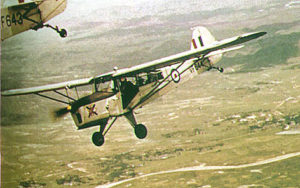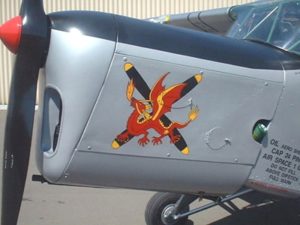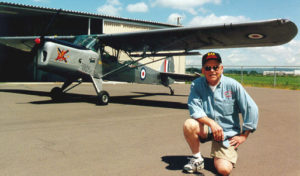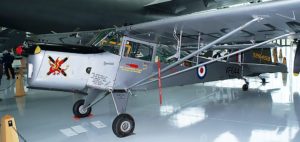Auster T7, Registration WE552 (Service with the HKAAF 20th April 1953 to 1970 and the RHKAAF 1970 to January 1971.) | |||||
On the 17th July 1950 L.A. Leetham took Auster WE552 for her first flight at the Rearsby Auster factory. She was then sent to 227 Squadron RAF, operational conversion unit and air observation post (OCU/AOP) school, where unfortunately she sustained Cat 4 damage when another Auster ran into the back of her, damaging her tail section. She returned to Rearsby where repairs were completed in September 1951 | |||||
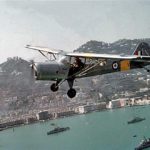 | Following the repairs she returned to the RAF and was assigned to the Hong Kong Auxiliary Air Force. At first she flew in standard RAF Trainer colours of silver with yellow bands on the wings. | 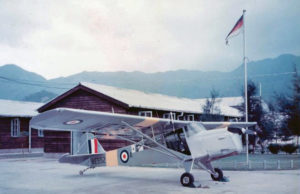 | |||
| 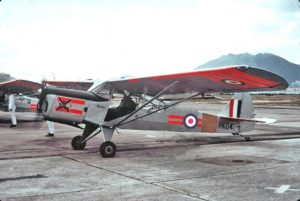 |
| |||
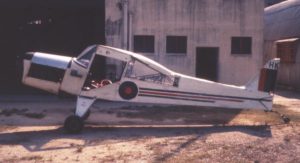 | During the late sixties the livery of the HKAAF fleet was progressively changed. It consisted of an all white airframe with RAF rondels on the wings and rondels with blue, red and green stripes on the fuselage. | Seen on the right is HKG-4 with the last four cadet pilots to train in her, with their instructor. Left to right, Cadet Pilots Andrew Fraser, James Curtis, Gerry Higginson, John Spencer and Flt Lt Peter Adair RAF QFI. | 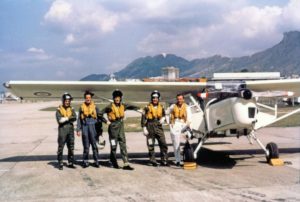 | ||
| |||||
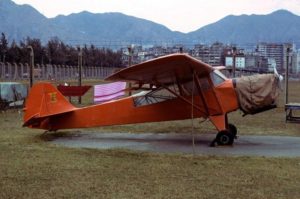 | HKG-4 then languished around the hangers at Kai-Tak, and eventually ended up at the FEFTS (Far East Flying Training School) used as a training aide. | ||||
Several years later, WE552/HKG-4 was about to embark on another chapter in her colourful life! Anthony Galbraith and family, New Zealanders, came to learn of the existence of a largely unknown Auster project in Australia. Being particularly fond of the T.7, in February 2009 the family flew to Coobalture in Queensland to meet Ralph Cusack and the derelict Auster. | |||||
What they saw could so easily have been mistaken for a pile of junk. To the discerning eye, however, it was a beautiful piece of equipment yearning for a good home. | 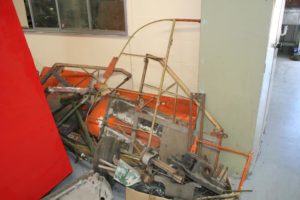 | ||||
| |||||
| Some months later this Auster (at this stage simply known as TAY223ES) arrived in New Zealand, was unloaded and moved into Anthony’s garage. A sorry site but surrounded by hope and enthusiasm! | 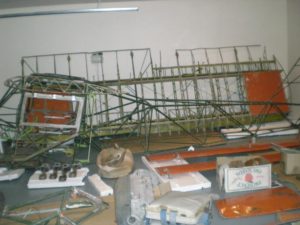 | ||||
The immediate priorities were to find a certifying aircraft engineer to oversee the rebuild, and to find out some history of her. After initial difficulty and skepticism by many, a very experienced engineer, Jay McIntyre, specialist in vintage aircraft, saw through what looked like a pile of junk and agreed to take the project on structurally. The second priority is where Val Penlington, a fellow New Zealander, entered the scene. Val, widow of Ross Penlington, a former Cammanding Officer and later Honorary Air Commodore of the Royal Hong Kong Auxiliary Air Force, was able to provide much of the history of this forlorn looking aeroplane, and put Anthony in touch with members of the RHKAAF who had been involved with HKG-4 when she had been in service with the Unit. Val also provided an authentic Auster wooden propellor, which had been presented to Ross on his retirement, together with the original Pilots Notes for AOP-6 and T-7. Once the proud history of WE552, later to be known as HKG-4, was learned, having served the whole of her flying career thus far with the Hong Kong Auxiliary Air Force an easy decision was taken. She would be restored as HKG-4 not as an RNZAF imitator. | |||||
 | HKG-4’s fuselage got x-rayed and was non-destructive tested by Safe Air at Blenhelm Aerodrome and although she had looked bad, structurally she was in remarkably good shape. Before long the boys at JEM Aviation, also at Blenhelm, had her fuselage frame repaired (after months of paint-stripping by hand) and painted back to original Auster green. Finally, she rolled out the hangar doors looking like a brand new structure! | ||||
| Following the work at Blenhelm she was shipped to Rangiora for fitting out and finishing, Every effort is being made to restore her to full military specification, with authentic parts being sourced from around the world. The rebuild is a labour of love, using whatever time can be made available between full-time work and domestic necessities. | 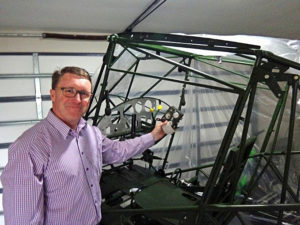 | ||||
No short-cuts are permitted, with the resulting long time-frame being accepted. The taxying trials are expected to take place maybe in 2023, with the first flight shortly thereafter. If you would like to follow progress on the rebuild, here is a link to her Facebook page https://www.facebook.com/Austerwe552/ | |||||
| * * * | |||||
| Auster AOP 6 Registration VF 644 | |||||
(Service with the HKAAF from 4th October 1949 to 28th October 1966) | |||||
Auster AOP 6 Registration VF643(Service with the HKAAF from 4th October 1949 to 1970 and the RHKAAF from 1970 to 7th February 1971) | ||||
After more than twenty-one years of sterling service she was finally struck off strength on 7th February 1971. Later that year, together with another AOP 6, VF644, two AOP 9s, XN407 and XN408, and salvaged and spare parts, VF643 was sold to E.J. “Buzz” Gothard of Chehalis, Washington, USA. The available information is that, after being rebuilt, VF643 (US registration N38220) and one of the AOP 9s (either US registration N38224 or N408XN) were later almost totally destroyed in accidents. In 2017 New Zealander Anthony Galbraith managed to locate the remains of VF643 in a barn in Vancouver, Canada, where it was being stored with an ex-Royal Canadian Air Force Auster and all the spares inventory from the RCAF. They were purchased and in October of that year they all arrived safely on the shores of New Zealand. Damon Edwards, a friend of Anthony Galbraith, bought VF643 / HKG-5 and his aim is to rebuild the aircraft in the livery of the HKAAF, with the ambition that one day HKG-5 will once more fly in formation with HKG-4. | ||||
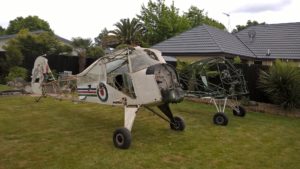 | In the mean-time take a look at these two proud aircraft as they stand together in October 2017 before VN643 / HKG-5 was shipped to Auckland for the rebuild. . . . . .and on the right, in the late 1960s, VF643 / HKG-5 in formation with another grand lady, VF644 whose story is told above. | 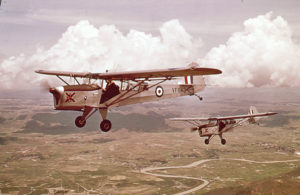 |
